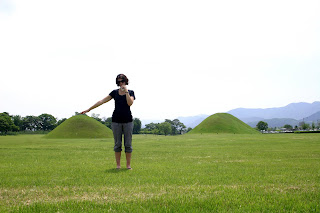A few weeks before the election was the beginning of the official Campaign Season (it's Korea, everything's scheduled). What this meant for us was that we woke up one morning to the sound of angry shouting into a PA system coming from town. Whenever anyone speaks to an audience in Korean they sound angry, and they almost always shout. So, we're hearing shouty angry urgent public announcements happening in town and our thoughts immediately turn to evacuation orders being given to the citizens of Yeoju in the aftermath of the shelling of Seoul. No such calamity-it's just campaign season.
I'm sure that campaigning manifests itself in other ways invisible to the untrained eyes and ears of a foreigner. But as far as I can tell, it consists of little more than dressing up ajummas in coordinated, numbered t-shirts and sashes, directing them to dance, bow and sing at busy intersections, and setting up mobile stages with large PA systems on the backs of trucks. The presence of the candidate should not preclude the speakers from blasting beligerrent sounding speeches or grandma techno. These trucks may be anchored to a specific intersection or may be found careening across town, audio blasting all the while. Often, the ajumma dancing teams will square off across the road from each other, accompanied by their aforementioned campaign trucks.
A coordinated bow to every car that passes.
Standardization is the fabric that binds Korean society and the Korean economy together, and so too is it the rule of elections in Korea--particularly when it comes to graphic design. Every candidate has a campaign poster that looks identical or similar to his or her opponents': terrifying over-sized head-shot on a crappy photoshopped background with a huge graphic of their designated number (we never figured out if the message was "vote for number 3" or "vote for me under category 3"). T-shirt design must have also been standardized and regulated, along with all particulars pertaining to the ajumma sashes, which seemed to be required by law.
A final, overwhelming element of Korean campaigns are the candidates' building-sized banners (they literally just hang them up on the sides of buildings). These are typically just oversized versions of the campaign posters, but many are much more fun. One, for example, shows Our Candidate wearing a shirt and tie (they all do--corporate middle-manager is the ideal) whilst carrying a broadly smiling and very old grandmother on his back. He too is smiling and photoshopped to perfection/oblivion.
For two weeks we couldn't escape the screeching noise and the aggressive visuals of the campaign. It was bad in Yeoju, even worse in Gyeongju and I can't even begin to imagine how terrible it must have been in Seoul. I'm glad it's over but I'm glad to have seen it. It was nuts.
The election results (an afterthought, as far as I'm concerned) delivered a blow to the ruling conservative GNP party. It was a nationwide election for local seats and the opposition picked up more than expected. This is most relevant to the progress of the Four Rivers Project (terrible, massive river re-engineering without the use of environmental impact studies) and the possible re-location of government ministries from Seoul to a new city currently under construction in the heart of the country. Without going into these issues further, it should be mentioned that the President, Lee Myung Bak, is the former CEO of Hyundai Heavy Industries, which probably owns about 75% of all construction contracts in the country. Surprise!
If there is any sort of moral to this story: Democracy is ridiculous and funny no matter where you are.



































